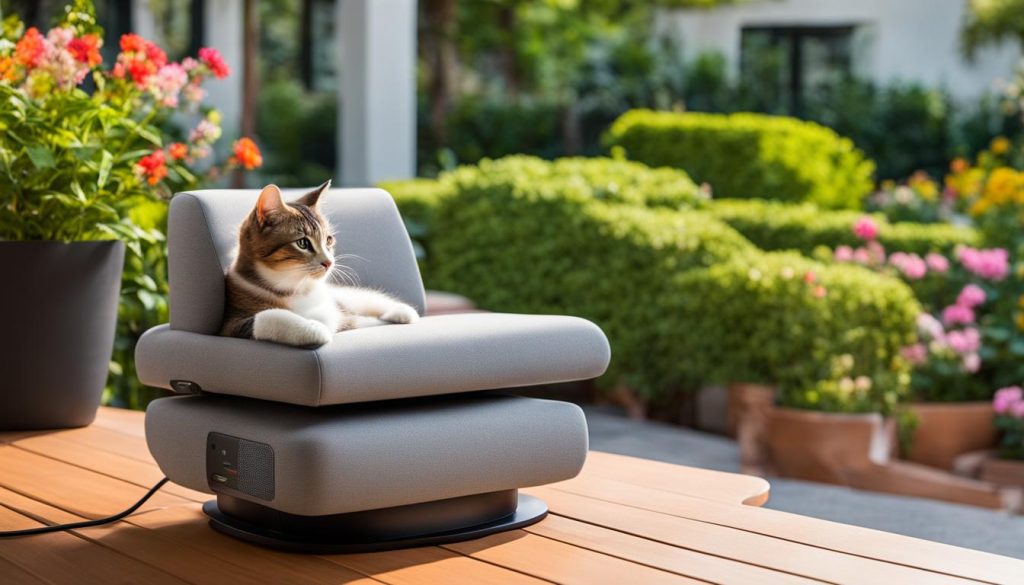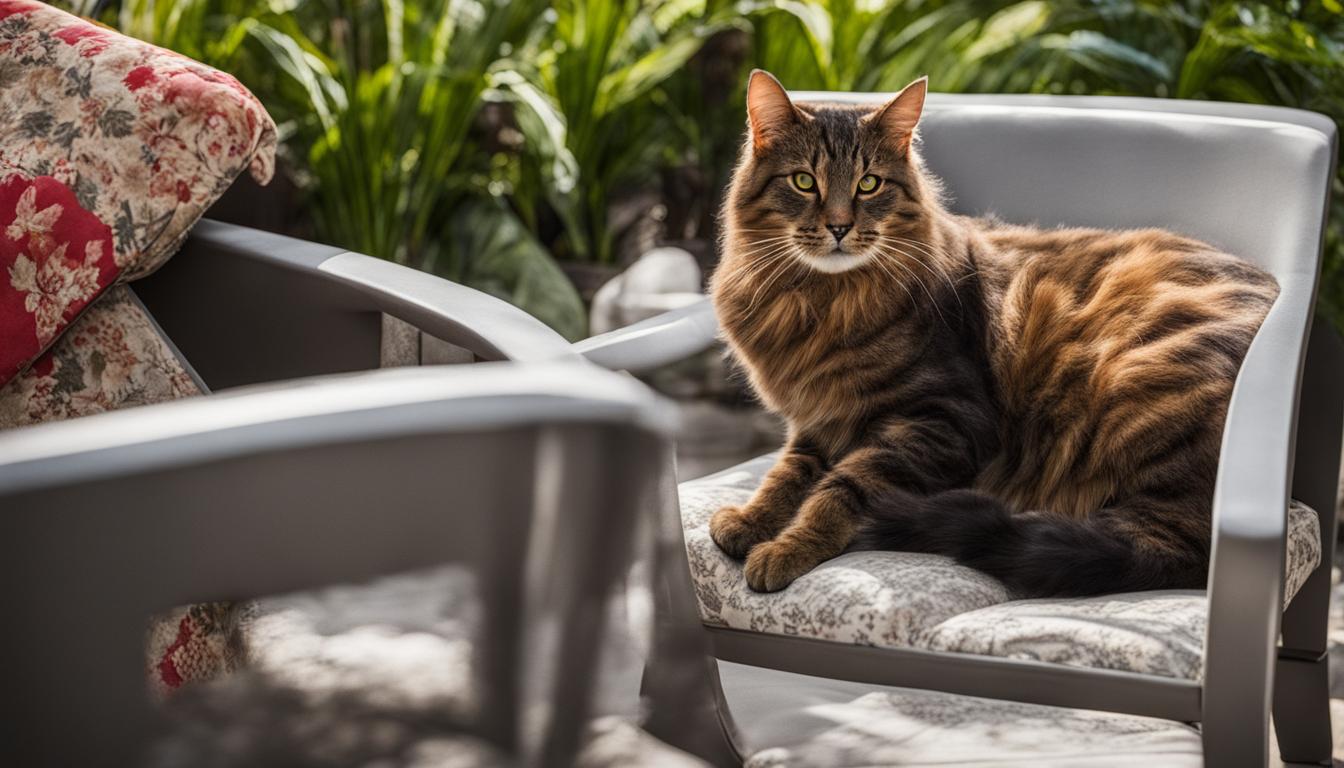Cats can be a nuisance when they scratch and leave hair on outdoor furniture. In this guide, I will provide effective tips and techniques to keep cats off your outdoor furniture, ensuring a scratch-free and clean patio environment.
Key Takeaways
- Implement visual deterrents such as motion-activated sprinklers or reflective surfaces.
- Use physical deterrents like double-sided tape or plastic sheeting to create barriers.
- Try liquid cat repellents, such as citrus-based sprays or vinegar mixtures applied directly to the furniture.
- Plant cat-repellent plants like lavender, rue, rosemary, or Scaredy Cat plant in your garden.
- Create barriers around your garden using chicken wire, mesh fencing, or prickly shrubs.
Visual Deterrents for Cat Repellent
When it comes to keeping cats off your outdoor furniture, visual deterrents can be highly effective. By utilizing certain strategies, you can create a space that cats find unappealing, reducing the likelihood of them scratching or lounging on your patio cushions. Here are a few visual deterrents that can help in your mission to protect your outdoor furniture:
Motion-Activated Sprinklers
Motion-activated sprinklers are an excellent way to startle cats and make them feel uncomfortable approaching your outdoor furniture. These devices are triggered by their movement and emit a sudden burst of water, which can startle and deter them from entering the area.
Reflective Surfaces
Placing reflective surfaces near your outdoor furniture can create the illusion of movement, making cats think that another animal is present. Mirrors, aluminum foil, or plastic wrap can be strategically positioned to help deter cats and prevent them from scratching or lounging on your cushions.
Moving Objects
Adding items that move easily with the wind, such as pinwheels or flags, near your outdoor furniture can further discourage cats from approaching. The unpredictable movement and sound can startle them, making them think twice before venturing near your cherished patio seating.
Table: Different Types of Visual Deterrents
| Visual Deterrent | Description |
|---|---|
| Motion-Activated Sprinklers | These devices startle cats with bursts of water when they detect movement, making them uncomfortable. |
| Reflective Surfaces | Mirrors, aluminum foil, or plastic wrap create visual illusions that deter cats from approaching. |
| Moving Objects | Items like pinwheels or flags that move with the wind startle cats and discourage them from approaching your outdoor furniture. |
Physical Deterrents for Cat Repellent
Cats can be persistent when it comes to finding a comfortable spot on your outdoor furniture. To protect your patio from their scratching and hair, physical deterrents can be highly effective. Here are some methods you can use:
Double-Sided Tape
One physical deterrent for cats is double-sided tape. Cats dislike the sticky texture of the tape on their paws, so they will be reluctant to jump onto surfaces covered with it. Simply apply strips of double-sided tape to areas where cats tend to sit or scratch. Remember to test a small area first to ensure it doesn’t damage the furniture.
Plastic Sheeting
Another option is to drape plastic sheeting over your outdoor furniture. This creates a physical barrier that prevents cats from jumping up onto the cushions. Make sure the sheeting is secure and covers the entire surface of the furniture. Cats will find the slippery surface unappealing and will seek alternative spots.
Chicken Wire Fencing
For larger areas or when dealing with persistent cats, chicken wire fencing can be a reliable solution. Create a barrier around your patio or garden using the fencing, ensuring it is tall enough to prevent cats from jumping over. This method not only keeps cats away from your outdoor furniture but also acts as a deterrent for other animals.
| Physical Deterrents | Effectiveness | Cost |
|---|---|---|
| Double-Sided Tape | High | Low |
| Plastic Sheeting | Moderate | Low |
| Chicken Wire Fencing | High | Medium |
Liquid Cat Repellent
If you’re looking for an effective way to keep cats off your outdoor furniture, liquid cat repellent is a great option. These repellents are designed to deter cats from scratching and marking furniture surfaces, helping you maintain a cat-free patio space. There are a few different types of liquid cat repellents available, including citrus-based sprays and vinegar spray.
Citrus-based sprays are made with natural ingredients like lemon juice and lime peels, which have a strong odor that cats find unpleasant. Simply spray the repellent directly onto your outdoor furniture to discourage cats from scratching or marking it. Vinegar spray is another effective option, as cats dislike the smell of vinegar. Mix equal parts white vinegar and water in a spray bottle and apply it to the areas you want to protect.
| Pros | Cons |
|---|---|
| Effectively deters cats from scratching and marking outdoor furniture | May need to reapply the repellent periodically, especially after rain |
| Safe and natural alternative to harsh chemicals | Strong odor may be unpleasant for some people as well |
| Easy to apply with a spray bottle | May not be as effective for all cats |
When using liquid cat repellent, it’s important to follow the instructions on the product packaging and reapply as needed. It’s also a good idea to test the repellent on a small, inconspicuous area of your furniture before applying it to the entire surface. This will help ensure that the repellent doesn’t cause any damage or discoloration.
If you’re struggling to keep cats off your outdoor furniture, give liquid cat repellents a try. Their strong scents and deterrent properties can help create a cat-free zone, allowing you to enjoy your outdoor space without the worry of scratched or marked furniture.
Cat-Repellent Plants for Garden Bed Protection
When it comes to keeping cats away from your garden and outdoor furniture, planting cat-repellent plants can be a natural and effective solution. These plants have strong odors that cats find unpleasant, deterring them from entering your garden and accessing your outdoor seating. Here are some popular cat-repellent plants:
- Lavender: Not only does lavender add a lovely fragrance to your garden, but its strong scent repels cats.
- Rue: Rue is known for its pungent odor, which cats find highly unpleasant.
- Rosemary: This aromatic herb not only adds flavor to your dishes but also acts as a natural cat deterrent.
- Scaredy Cat plant: As the name suggests, this plant is specifically bred to repel cats with its strong odor.
By including these cat-repellent plants in your garden, you can create a barrier that cats are less likely to cross. Not only will this help protect your outdoor furniture, but it will also contribute to a cat-free garden environment.

Table: Comparison of Cat-Repellent Plants
| Plant | Odor | Effectiveness | Additional Benefits |
|---|---|---|---|
| Lavender | Strong | High | Attracts pollinators |
| Rue | Pungent | Medium | Repels other pests |
| Rosemary | Aromatic | Medium | Culinary uses |
| Scaredy Cat plant | Strong | High | Specifically bred for cat deterrence |
“Including these cat-repellent plants in your garden creates a natural barrier that cats find highly unpleasant, reducing the likelihood of them accessing your outdoor furniture.” – Cat Repellent Expert
Creating Barriers Around Your Garden
When it comes to keeping cats off your outdoor furniture, creating barriers around your garden is an effective solution. These barriers prevent cats from entering and reaching your cherished patio seating. There are a few options you can consider when implementing garden barriers.
Chicken Wire and Mesh Fencing
One popular choice is using chicken wire or mesh fencing to fence off the area. These materials provide a sturdy and durable barrier that keeps cats out while still allowing air and sunlight to reach your plants. You can easily install them around your garden to create a secure boundary, protecting your outdoor furniture from unwanted feline visitors.
Prickly Shrubs for Natural Defense
Another strategy is to incorporate prickly shrubs into your garden. Plants like holly or barberry have thorny leaves, creating an uncomfortable environment for cats. By strategically planting these shrubs around the perimeter of your garden, you deter cats from accessing your outdoor furniture. The prickly texture acts as a deterrent, making it difficult for cats to maneuver through the shrubs and reach your cherished seating area.
By implementing these garden barriers, you can create a cat-free zone and protect your outdoor furniture from scratch marks and fur. Whether you opt for chicken wire, mesh fencing, or prickly shrubs, these barriers serve as a physical deterrent, ensuring a peaceful and cat-free patio environment.
Motion-Activated Devices for Cat Repellent
When it comes to keeping cats away from your outdoor furniture, motion-activated devices can be highly effective. These devices are designed to detect the movement of cats and emit a sudden noise, light, or stream of water to startle them and deter them from approaching. Motion-activated sprinklers, for example, can be strategically placed near your outdoor seating area to create a deterrent zone that cats will learn to avoid. The sudden burst of water will surprise the cats and make them associate the area with an unpleasant experience. Similarly, motion-activated lights can be placed around your patio to startle cats and make them feel uncomfortable, discouraging them from coming close to your furniture.
An excellent option for motion-activated cat repellent is an ultrasonic repeller. These compact devices emit a high-frequency sound that is only audible to cats, effectively repelling them without disturbing humans. The ultrasonic sound is highly unpleasant for cats, making them want to stay away from the area where the device is active. Ultrasonic repellers can be placed near your outdoor furniture or installed around your garden to protect both your plants and seating area from cat intrusions. When using motion-activated devices for cat repellent, it’s important to consider the placement and coverage area to ensure maximum effectiveness.
“Motion-activated devices are a user-friendly and humane way to keep cats off your outdoor furniture. By utilizing sudden noises, lights, and water streams, these devices startle cats and create a negative association with your furniture.”
Adding motion-activated devices to your cat deterrent strategy can be a valuable addition to other methods you may be using. These devices provide a hands-off approach to keeping cats away from your outdoor spaces, minimizing the need for constant supervision or manual intervention. With the right placement and maintenance, motion-activated devices can help you achieve a cat-free patio environment, allowing you to enjoy your outdoor furniture without the worry of scratches or mess left behind by curious felines.
Remember to regularly check and maintain your motion-activated devices to ensure they are functioning properly. It’s also important to be mindful of any local regulations or restrictions regarding the use of certain devices. By incorporating motion-activated devices into your cat repellent arsenal, you can create a peaceful and cat-free outdoor space that you can enjoy year-round.
| Motion-Activated Devices for Cat Repellent |
|---|
 |
Homemade Cat Repellent Sprays
If you’re looking for natural and cost-effective ways to keep cats off your outdoor furniture, homemade cat repellent sprays can be a great solution. These DIY sprays are easy to make and can help deter cats from scratching or lounging on your patio chairs and tables. There are several homemade options to choose from, each with its own effectiveness.
Vinegar Spray
One popular homemade cat repellent spray is the vinegar spray. Cats dislike the strong smell of vinegar, making it an effective deterrent. To make this spray, simply mix equal parts white vinegar and water in a spray bottle. Then, spray the mixture directly onto the surfaces of your outdoor furniture. Repeat this process regularly, especially after rain showers, to ensure the scent remains strong.
Citrus-Based Sprays
Cats also dislike the scent of citrus fruits such as lemons and oranges. You can create a citrus-based spray by combining lemon juice, orange oil, or vinegar with water in a spray bottle. Apply the mixture to your outdoor furniture, paying special attention to areas where cats tend to scratch or sleep. The citrus scent will naturally deter cats, encouraging them to find a more appealing spot.
Aluminum Foil
Another simple yet effective homemade deterrent is aluminum foil. Cats are generally put off by the noise and texture of foil, making it an easy way to protect your outdoor furniture. Simply place sheets of aluminum foil over the areas where you want to keep cats away. The sound and feel of the foil will discourage cats from jumping or scratching on your furniture.
Incorporating homemade cat repellent sprays into your outdoor furniture maintenance routine can help create a cat-free environment. Whether you choose vinegar spray, citrus-based sprays, or aluminum foil, these natural repellents offer a safe and humane way to keep cats away from your prized patio pieces.
Training and Cat-Friendly Alternatives
Cats can be taught to stay away from outdoor furniture through proper training techniques. One effective approach is to provide cats with alternative scratching options, such as scratching posts or boards. These alternatives should be placed near the outdoor furniture to redirect their scratching behavior. Encouraging cats to use these designated scratching areas can help protect your outdoor furniture from damage. Remember to reward your cat with treats or praise when they use the scratching posts, reinforcing the positive behavior.
Indoor cats require special care and attention to ensure their well-being. Providing interactive toys and perches near windows can keep them entertained and stimulated, reducing the likelihood of them venturing outside and onto your outdoor furniture. High-quality cat food that meets their nutritional needs is essential for their overall health and can also contribute to minimizing any desire to explore outdoors. Regular visits to the veterinarian, including checkups and vaccinations, are crucial for maintaining the health of indoor cats.
Indoor Cat Care Tips:
- Provide interactive toys and perches near windows for entertainment.
- Use high-quality cat food that meets their nutritional needs.
- Ensure regular veterinary checkups and vaccinations.
By training cats to use scratching posts and providing them with an enriching indoor environment, you can help divert their attention from your outdoor furniture. Catering to their needs and ensuring their well-being will ultimately create a harmonious environment for both you and your feline companions.
Conclusion
By implementing a combination of visual, physical, and chemical cat deterrents, you can successfully keep cats off your outdoor furniture. Visual deterrents like motion-activated sprinklers or reflective surfaces, physical deterrents such as double-sided tape or plastic sheeting, and chemical deterrents like citrus-based sprays or vinegar mixtures can all contribute to a cat-free outdoor space.
Additionally, incorporating cat-repellent plants in your garden and creating barriers around it can further discourage cats from accessing your outdoor furniture. Planting lavender, rue, rosemary, or the Scaredy Cat plant will naturally repel cats with their strong odors. Fencing off the garden area with chicken wire or mesh fencing will create a physical barrier, while prickly shrubs like holly or barberry will make it difficult for cats to access your furniture.
Remember to provide appropriate cat care and consider training techniques when dealing with indoor cats. By offering a scratching post as an alternative to the furniture, providing interactive toys, and ensuring high-quality nutrition, you can train your cat to stay away from outdoor furniture. Regular veterinary visits and checkups are also essential for the health and well-being of indoor cats.
FAQ
How can I keep cats off my outdoor furniture?
There are several effective methods for deterring cats from outdoor furniture. Visual deterrents, such as motion-activated sprinklers or reflective surfaces, can startle cats and make them uncomfortable. Physical deterrents, like double-sided tape or plastic sheeting, create unpleasant sensations when cats try to jump on them. Liquid cat repellents, such as citrus-based sprays or vinegar mixtures, can be applied to the furniture surface. Planting cat-repellent plants in your garden and creating barriers around it can also help keep cats away from your outdoor furniture.
What are some visual deterrents for cat repellent?
Visual deterrents that can help keep cats off outdoor furniture include motion-activated sprinklers, reflective surfaces like mirrors or aluminum foil, and items that move easily with the wind, such as pinwheels or flags.
What are some physical deterrents for cat repellent?
Physical deterrents for keeping cats off outdoor furniture include double-sided tape placed on areas where cats like to sit, plastic sheeting draped over the furniture, and chicken wire fencing to create a barrier.
Are there any liquid cat repellents I can use?
Yes, there are liquid cat repellents available that can be sprayed onto outdoor furniture. Citrus-based sprays made with lemon juice and/or lime peels, or a mix of vinegar and water can be effective in deterring cats.
What are some cat-repellent plants I can use in my garden?
Certain plants, such as lavender, rue, rosemary, and the Scaredy Cat plant, have strong odors that cats find unpleasant and will naturally avoid. Planting these in your garden can help keep cats away from your outdoor furniture.
How can I create barriers around my garden to keep cats out?
You can create barriers around your garden by using chicken wire or mesh fencing. Additionally, planting prickly shrubs like holly or barberry around the perimeter of your garden can act as a physical barrier, making it difficult for cats to access your outdoor furniture.
What are some motion-activated devices for cat repellent?
Motion-activated sprinklers and lights are effective at scaring away cats from your garden and outdoor furniture. Ultrasonic repellers that emit a sound only cats can hear can also be helpful in deterring cats from entering your yard.
Are there any homemade cat repellent sprays I can make?
Yes, there are homemade solutions that can be sprayed onto outdoor furniture. Spraying a mixture of equal parts white vinegar and water, or citrus-based sprays made with lemon juice, orange oil, or vinegar mixed with water can be effective in deterring cats.
How can I train my cat to stay away from outdoor furniture?
Training your cat to stay away from outdoor furniture can be achieved by providing a scratching post as an alternative and using positive reinforcement techniques. Indoor cats should also be provided with interactive toys, perches near windows for entertainment, and high-quality food. Regular veterinary visits are also important for indoor cat care.
How can I keep cats off my outdoor furniture?
By implementing a combination of visual, physical, and chemical cat deterrents, planting cat-repellent plants in your garden, creating barriers, and using motion-activated devices, you can successfully keep cats off your outdoor furniture.



